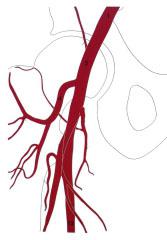VASCULAR.EXPERT
mini-invasives
technics

Marc FITOUSSI M.D
Vascular Surgeon.
18-22 Queen Anne Street
W1G 8HU London
+44 20 7034 3326
VASCULAR.EXPERT

Marc FITOUSSI M.D
Vascular Surgeon.
18-22 Queen Anne Street
W1G 8HU London
+44 20 7034 3326

Disease

SYMPTOMS: CLASSIFICATION by LERICHE ET FONTAINE
The severity depends on the pain felt by the patient and determines a stage.
- Stage I : asymptomatic and absence of a pulse
At the start, there is no pain. Only a pulse has disappeared during a systematic medical exam.
- Stage II : intermittent claudication (pain during effort)
- pain
- to a certain type of cramps or feelings of tiredness. There could also be a feeling of tightening, twisting, burning or maybe just a “pins and needle” sensation
- in a few muscular groups (buttocks, thighs, calf)
- having appeared during effort (exercise, taking a walk…)
- walking perimeter: the pain always comes within the same distance (on flat terrain, at identical speed). The walking perimeter is a good way to tell how severe the disease is. If decreasing, it can reveal a worsening of the condition.
- The pain usually disappears with rest.
- Stage III : decubitus Pain
- pain
- located in the extremities (fingers and toes) which are cold
- even during rest
- Walking around is almost impossible
- Worsening with lying down. Intense night pains, often intolerable.
- The patient is then forced to let the leg hang from the side of the bed which will appease the pain very progressively.
These pains are representative of an advanced stage of the disease and require urgent medical advice before the occurrence of ulcers or gangrene.
- Stage IV : Trophic disorders.
This is gangrene. By restoring blood flow into the arteries with surgery, the amputation can often be prevented. If not, a bigger part of the limb can still be saved.
critic ischemia is defined by :
- decubitus pain since more than 15 days or ulcer
- associated to a distal pressure ≤ 50 mmHg
Its evolution non treated is gangrene and amputation
CLINICAL EXAMINATION
Temperature : skin is cold to the touch,
Decrease or disappearance of arterial pulses.
The pulses that can be felt in the inferior limbs are:
- the femoral pulse (around the groin)
- popliteal pulse : behind the knee,
- tibialis posterior pulse at the ankle, behind the internal malleolus
- dorsalis pedis pulse : located on top of the foot
Decrease of the distal pressure index
OTHER ARTERIES IN THE BODY CAN BE AFFECTED :
1/ Ateries of the superior limbs :
- Stage I : blood pressure is decreased in one arm.
- Stage II : pain during exercise.
- Stage III : constant pain.
- Stage IV : gangrene of the fingers.
2/ Arteries supplying the brain:
Responsible for serious accidents: hemiplegia, speech loss, visual disorders, vertigo. Thankfully, these lesions can be uncovered beforehand with an Doppler instrument.
In case of an important shrinkage (above 70%), even without the occurrence of an accident, a surgical intervention is critical to eliminate any possible future risk.
3/ Heart arteries : If diseased, they can cause angina, and even a myocardial infarction.
These lesions can be uncovered beforehand with an electrocardiogram.
4/ Digestive artery: They can cause very serious abdominal accidents.
5/ Genital arteries: They can cause erectile dysfunction.
6/ Renal arteries: Affecting them causes hypertension.

VASCULAR.EXPERT
mini-invasives technics
18-22 Queen Anne Street W1G 8HU London
+44 20 7034 3326